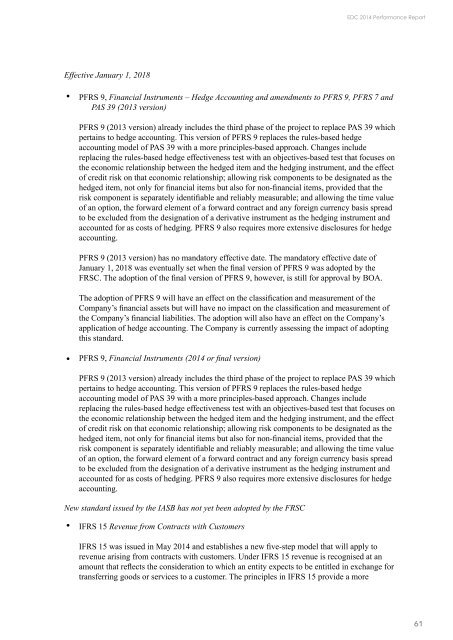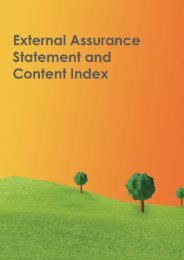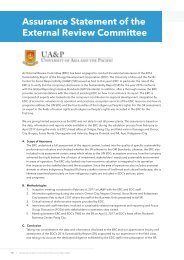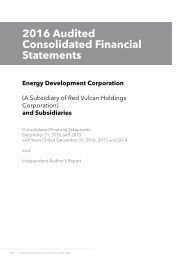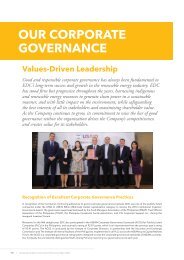2014 Financial Statement
Create successful ePaper yourself
Turn your PDF publications into a flip-book with our unique Google optimized e-Paper software.
EDC <strong>2014</strong> Performance Report<br />
Effective January 1, 2018<br />
PFRS 9, <strong>Financial</strong> Instruments – Hedge Accounting and amendments to PFRS 9, PFRS 7 and<br />
PAS 39 (2013 version)<br />
PFRS 9 (2013 version) already includes the third phase of the project to replace PAS 39 which<br />
pertains to hedge accounting. This version of PFRS 9 replaces the rules-based hedge<br />
accounting model of PAS 39 with a more principles-based approach. Changes include<br />
replacing the rules-based hedge effectiveness test with an objectives-based test that focuses on<br />
the economic relationship between the hedged item and the hedging instrument, and the effect<br />
of credit risk on that economic relationship; allowing risk components to be designated as the<br />
hedged item, not only for financial items but also for non-financial items, provided that the<br />
risk component is separately identifiable and reliably measurable; and allowing the time value<br />
of an option, the forward element of a forward contract and any foreign currency basis spread<br />
to be excluded from the designation of a derivative instrument as the hedging instrument and<br />
accounted for as costs of hedging. PFRS 9 also requires more extensive disclosures for hedge<br />
accounting.<br />
PFRS 9 (2013 version) has no mandatory effective date. The mandatory effective date of<br />
January 1, 2018 was eventually set when the final version of PFRS 9 was adopted by the<br />
FRSC. The adoption of the final version of PFRS 9, however, is still for approval by BOA.<br />
The adoption of PFRS 9 will have an effect on the classification and measurement of the<br />
Company’s financial assets but will have no impact on the classification and measurement of<br />
the Company’s financial liabilities. The adoption will also have an effect on the Company’s<br />
application of hedge accounting. The Company is currently assessing the impact of adopting<br />
this standard.<br />
PFRS 9, <strong>Financial</strong> Instruments (<strong>2014</strong> or final version)<br />
PFRS 9 (2013 version) already includes the third phase of the project to replace PAS 39 which<br />
pertains to hedge accounting. This version of PFRS 9 replaces the rules-based hedge<br />
accounting model of PAS 39 with a more principles-based approach. Changes include<br />
replacing the rules-based hedge effectiveness test with an objectives-based test that focuses on<br />
the economic relationship between the hedged item and the hedging instrument, and the effect<br />
of credit risk on that economic relationship; allowing risk components to be designated as the<br />
hedged item, not only for financial items but also for non-financial items, provided that the<br />
risk component is separately identifiable and reliably measurable; and allowing the time value<br />
of an option, the forward element of a forward contract and any foreign currency basis spread<br />
to be excluded from the designation of a derivative instrument as the hedging instrument and<br />
accounted for as costs of hedging. PFRS 9 also requires more extensive disclosures for hedge<br />
accounting.<br />
New standard issued by the IASB has not yet been adopted by the FRSC<br />
IFRS 15 Revenue from Contracts with Customers<br />
IFRS 15 was issued in May <strong>2014</strong> and establishes a new five-step model that will apply to<br />
revenue arising from contracts with customers. Under IFRS 15 revenue is recognised at an<br />
amount that reflects the consideration to which an entity expects to be entitled in exchange for<br />
transferring goods or services to a customer. The principles in IFRS 15 provide a more<br />
61


